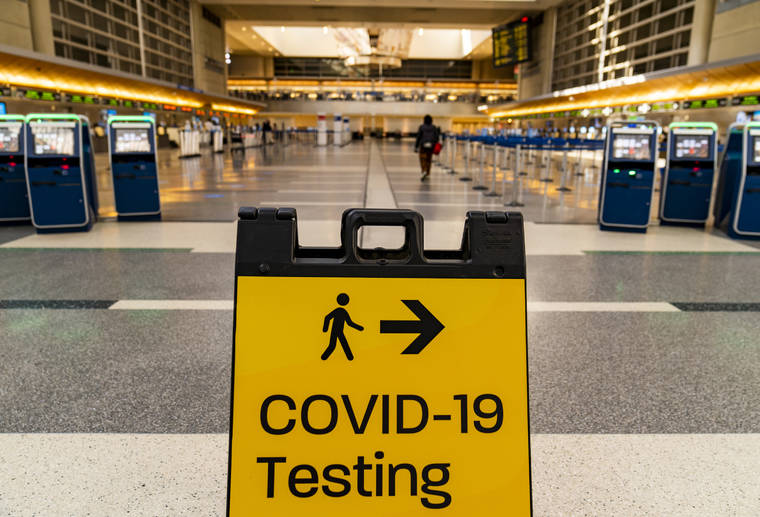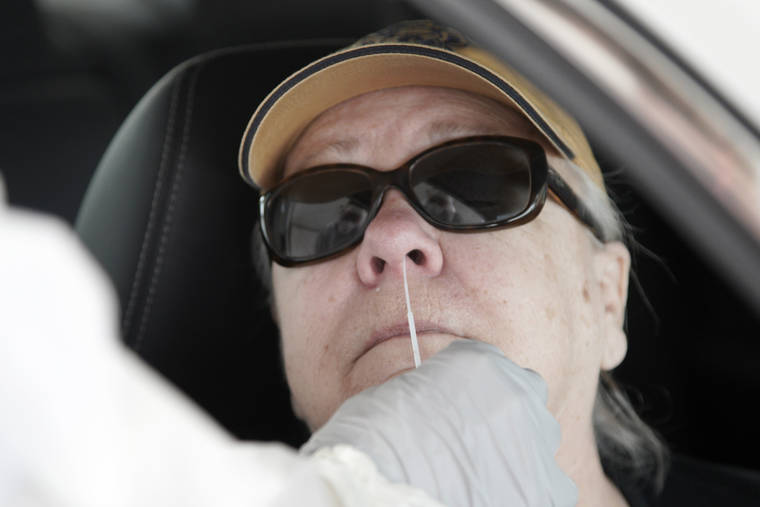A roundup of some of the most popular but completely untrue stories and visuals of the week. None of these are legit, even though they were shared widely on social media. The Associated Press checked them out. Here are the facts:
Hydroxychloroquine cannot be made at home using citrus
CLAIM: The drug Hydroxychloroquine can be made at home by boiling citrus peels in water.
THE FACTS: A video circulating on TikTok falsely suggests the drug hydroxychloroquine can be made at home by boiling grapefruit and lemon peels in water.
“Today we’re going to make our own hydroxychloroquine,” says the woman in the video, who identifies herself as an intuitive healer. “This is all you need. You need three organic lemons and three organic grapefruit. You want the rinds. That’s where all the healing properties are.”
But that’s not how hydroxychloroquine is made.
“Hydroxychloroquine cannot be made by boiling grapefruit and lime rinds, or any other citrus rinds,” said Dr. Joseph Fortunak, professor of chemistry and pharmaceutical sciences at Howard University. “Hydroxychloroquine is made by chemical synthesis ‘in the lab.’ It has never been reported as a natural product from any plant or animal.” Fortunak said the process of boiling citrus rinds in water isolates a natural chemical compound called limonene, which has health benefits, but is “assuredly not hydroxychloroquine.”
Former President Donald Trump repeatedly touted the use of hydroxychloroquine to treat COVID-19 infection, but health experts and health agencies within his administration said the drug is not safe or effective for treating the disease, The Associated Press has reported. The drug is routinely used to treat malaria, lupus and rheumatoid arthritis.
Schedule of ‘planned COVID-19 variants’ is fake
CLAIM: A table shows a list of planned COVID-19 variants and when they will be “released” to the public.
THE FACTS: As the highly transmissible delta variant of the coronavirus contributes to infection surges across the United States and the world, social media users are falsely claiming the emergence of new variants is a planned ploy by universities, nonprofits and global elites.
“These are the PLANNED COVID-19 VARIANTS – just look at the dates when they will be ‘released’ to the media,” read several posts shared on Instagram, Facebook, Twitter and TikTok. The posts included an image of a table in Spanish, which listed “launch” dates between 2021 and 2023 for 21 potential COVID-19 variants named after the Greek alphabet. Next to the table, the posts included logos of universities and organizations including Johns Hopkins University, the World Health Organization, the World Economic Forum and the Bill and Melinda Gates Foundation. The table doesn’t represent the work of these organizations, nor any legitimate scientific organization.
The World Economic Forum and the Bill and Melinda Gates Foundation both responded to Associated Press queries to confirm the document wasn’t real.
The table also falsely claims the delta variant of the coronavirus emerged in June 2021. It was first detected in India in October 2020. Finally, the posts ignore that variants occur in the population through random mutations and are not created by humans.
It is very challenging to predict when another serious variant will emerge or how many will affect the population in the years ahead, according to Dr. Christopher Murray, a public health researcher and director of the Institute for Health Metrics and Evaluation at the University of Washington. So far, Murray said, researchers know about four serious variants circulating in the global population. That’s after about 2 billion cases of COVID-19 have been identified worldwide. Given that information, Murray said, his best guess is that a new serious variant will emerge once every 500 million infections. Still, he says, it’s “impossible” to know for certain.
“That’s a crazy wild guess but it’s what we’ve observed,” Murray said. “The goal of predicting the next evolutions is quite hard.”
CDC encourages use of new tests that detect both COVID-19 and the flu
CLAIM: The Centers for Disease Control and Prevention revoked Emergency Use Authorization for coronavirus PCR tests because they were inaccurate, led to false positives and confused positive influenza cases with COVID-19.
THE FACTS: The claim is false. The CDC is taking steps to phase out one coronavirus test that was developed early in the pandemic, not because of inaccurate results, but because newer tests can simultaneously test patients for influenza.
The FDA has approved roughly 280 polymerase chain reaction, or PCR, coronavirus tests, which determine whether sequences from the virus’s genome are present in a patient’s nasal swab. Early in the pandemic, in February 2020, the CDC introduced a coronavirus PCR test, known as the “CDC 2019-Novel Coronavirus (2019-nCoV) Real-Time RT-PCR Diagnostic Panel.”
On July 21, the CDC announced that after this year, it would no longer request an Emergency Use Authorization from the FDA for that one test, which means laboratories will stop using it. Kristen Nordlund, health communication specialist at the CDC, told The Associated Press the agency made the move because newer PCR testing options now exist.
“The CDC 2019 Novel Coronavirus (2019 nCoV) Real-Time RT-PCR Diagnostic Panel met an important unmet need when it was developed and deployed and has not demonstrated any performance issues,” Nordlund said. She said the agency was encouraging labs to switch to tests that can detect influenza at the same time, since it will “save both time and resources.”
But social media users misinterpreted and misrepresented the announcement. False claims circulated on Twitter, Facebook and Instagram that the CDC’s move meant the agency and the FDA had admitted PCR tests do not work. Some posts online falsely said the test was unable to differentiate between coronavirus and influenza, leading to inflated COVID-19 counts and depressed flu counts.
In fact, PCR tests are designed to detect very specific areas of the viral genome, so tests do not get confused between which virus is present, said Matthew Binnicker, director of the clinical virology lab at the Mayo Clinic in Rochester, Minnesota.
“PCR tests, including the one developed by the CDC, are highly accurate and are able to differentiate between SARS-CoV-2 and influenza,” Binnicker said. “In other words, a COVID-19 test will not be positive if a person really has influenza, and vice versa.”
Binnicker said there are benefits to having one test that can detect both viruses, since the symptoms for both illnesses are often similar early on. Furthermore, neither the CDC nor the FDA has cast any doubt on the effectiveness of PCR technology.
“PCR tests are generally considered to be the ‘gold standard’ for COVID-19 diagnosis,” said James McKinney, a press officer for the FDA.
COVID-19 variants can be tested through genome sequencing
CLAIM: No test can identify COVID-19 variants. Tests can only determine if a person is positive or negative for the disease.
THE FACTS: Social media users are taking advantage of growing concerns around the coronavirus delta variant to push out misinformation online, including false claims that health professionals are lying to patients about contracting the variant and that a test for it does not exist. In fact, it is possible to test for variants using genome sequencing.
“It’s the patterns of mutations in the genome that determine the differences,” said Dr. Phil Febbo, chief medical officer for Illumina, a San Diego-based company that develops genomic sequencing technologies.
Viruses mutate or change as they spread, creating variants. Variants can make a virus more transmissible or lead to more severe disease. Repositories online allow medical officials to scan and see all the different sequences of the virus. Researchers sequence viruses to answer such questions as whether a given variant is more or less dangerous and whether it increases risk for people, said Dr. Angela Branche, co-director of the University of Rochester Vaccine Treatment Evaluation Unit.
“It’s meant to help us understand how quickly the virus changes itself and the current protection you get after you are infected,” Branche said.
The delta variant was first detected in India and now makes up 83% of U.S. COVID-19 cases.
“We have seen cases skyrocket in the last few weeks. The vast majority of that is attributable to SARS-COV2 delta variant because we are sequencing a good chunk of all positive cases across the country,” said Joseph Fauver, associate research scientist in epidemiology at Yale University’s School of Public Health.




